Kaifeng Han
An overview of domain-specific foundation model: key technologies, applications and challenges
Sep 06, 2024Abstract:The impressive performance of ChatGPT and other foundation-model-based products in human language understanding has prompted both academia and industry to explore how these models can be tailored for specific industries and application scenarios. This process, known as the customization of domain-specific foundation models, addresses the limitations of general-purpose models, which may not fully capture the unique patterns and requirements of domain-specific data. Despite its importance, there is a notable lack of comprehensive overview papers on building domain-specific foundation models, while numerous resources exist for general-purpose models. To bridge this gap, this article provides a timely and thorough overview of the methodology for customizing domain-specific foundation models. It introduces basic concepts, outlines the general architecture, and surveys key methods for constructing domain-specific models. Furthermore, the article discusses various domains that can benefit from these specialized models and highlights the challenges ahead. Through this overview, we aim to offer valuable guidance and reference for researchers and practitioners from diverse fields to develop their own customized foundation models.
Target Localization with Macro and Micro Base Stations Cooperative Sensing
May 05, 2024Abstract:Addressing the communication and sensing demands of sixth-generation (6G) mobile communication system, integrated sensing and communication (ISAC) has garnered traction in academia and industry. With the sensing limitation of single base station (BS), multi-BS cooperative sensing is regarded as a promising solution. The coexistence and overlapped coverage of macro BS (MBS) and micro BS (MiBS) are common in the development of 6G, making the cooperative sensing between MBS and MiBS feasible. Since MBS and MiBS work in low and high frequency bands, respectively, the challenges of MBS and MiBS cooperative sensing lie in the fusion method of the sensing information in high and low-frequency bands. To this end, this paper introduces a symbol-level fusion method and a grid-based three-dimensional discrete Fourier transform (3D-GDFT) algorithm to achieve precise localization of multiple targets with limited resources. Simulation results demonstrate that the proposed MBS and MiBS cooperative sensing scheme outperforms traditional single BS (MBS/MiBS) sensing scheme, showcasing superior sensing performance
Collaborative Edge AI Inference over Cloud-RAN
Apr 09, 2024Abstract:In this paper, a cloud radio access network (Cloud-RAN) based collaborative edge AI inference architecture is proposed. Specifically, geographically distributed devices capture real-time noise-corrupted sensory data samples and extract the noisy local feature vectors, which are then aggregated at each remote radio head (RRH) to suppress sensing noise. To realize efficient uplink feature aggregation, we allow each RRH receives local feature vectors from all devices over the same resource blocks simultaneously by leveraging an over-the-air computation (AirComp) technique. Thereafter, these aggregated feature vectors are quantized and transmitted to a central processor (CP) for further aggregation and downstream inference tasks. Our aim in this work is to maximize the inference accuracy via a surrogate accuracy metric called discriminant gain, which measures the discernibility of different classes in the feature space. The key challenges lie on simultaneously suppressing the coupled sensing noise, AirComp distortion caused by hostile wireless channels, and the quantization error resulting from the limited capacity of fronthaul links. To address these challenges, this work proposes a joint transmit precoding, receive beamforming, and quantization error control scheme to enhance the inference accuracy. Extensive numerical experiments demonstrate the effectiveness and superiority of our proposed optimization algorithm compared to various baselines.
Integrated Sensing and Communication enabled Multiple Base Stations Cooperative Sensing Towards 6G
Oct 11, 2023Abstract:Driven by the intelligent applications of sixth-generation (6G) mobile communication systems such as smart city and autonomous driving, which connect the physical and cyber space, the integrated sensing and communication (ISAC) brings a revolutionary change to the base stations (BSs) of 6G by integrating radar sensing and communication in the same hardware and wireless resource. However, with the requirements of long-range and accurate sensing in the applications of smart city and autonomous driving, the ISAC enabled single BS still has a limitation in the sensing range and accuracy. With the networked infrastructures of mobile communication systems, multi-BS cooperative sensing is a natural choice satisfying the requirement of long-range and accurate sensing. In this article, the framework of multi-BS cooperative sensing is proposed, breaking through the limitation of single-BS sensing. The enabling technologies, including unified ISAC performance metrics, ISAC signal design and optimization, interference management, cooperative sensing algorithms, are introduced in details. The performance evaluation results are provided to verify the effectiveness of multi-BS cooperative sensing schemes. With ISAC enabled multi-BS cooperative sensing (ISAC-MCS), the intelligent infrastructures connecting physical and cyber space can be established, ushering the era of 6G promoting the intelligence of everything.
* 11 pages 6 figures
Iterative Signal Processing for Integrated Sensing and Communication Systems
Jun 08, 2023Abstract:Integrated sensing and communication (ISAC), with sensing and communication sharing the same wireless resources and hardware, has the advantages of high spectrum efficiency and low hardware cost, which is regarded as one of the key technologies of the fifth generation advanced (5G-A) and sixth generation (6G) mobile communication systems. ISAC has the potential to be applied in the intelligent applications requiring both communication and high accurate sensing capabilities. The fundamental challenges of ISAC system are the ISAC signal design and ISAC signal processing. However, the existing ISAC signal has low anti-noise capability. And the existing ISAC signal processing algorithms have the disadvantages of quantization errors and high complexity, resulting in large energy consumption. In this paper, phase coding is applied in ISAC signal design to improve the anti-noise performance of ISAC signal. Then, the effect of phase coding method on improving the sensing accuracy is analyzed. In order to improve the sensing accuracy with low-complexity algorithm, the iterative ISAC signal processing methods are proposed. The proposed methods improve the sensing accuracy with low computational complexity, realizing energy efficient ISAC signal processing. Taking the scenarios of short distance and long distance sensing into account, the iterative two-dimensional (2D) fast Fourier transform (FFT) and iterative cyclic cross-correlation (CC) methods are proposed, respectively, realizing high sensing accuracy and low computational complexity. Finally, the feasibility of the proposed ISAC signal processing methods are verified by simulation results.
Spectrum Sharing between High Altitude Platform Network and Terrestrial Network: Modeling and Performance Analysis
Jun 08, 2023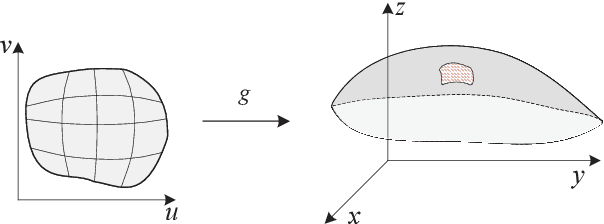
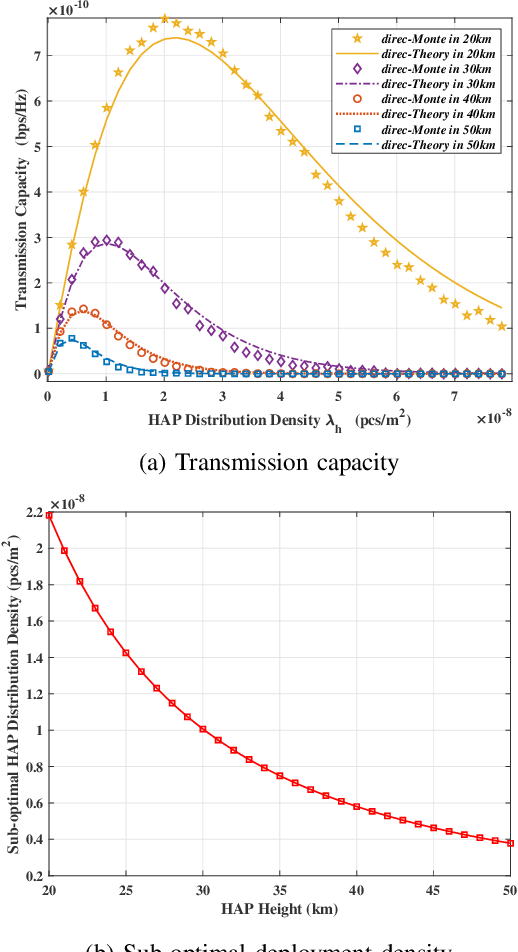
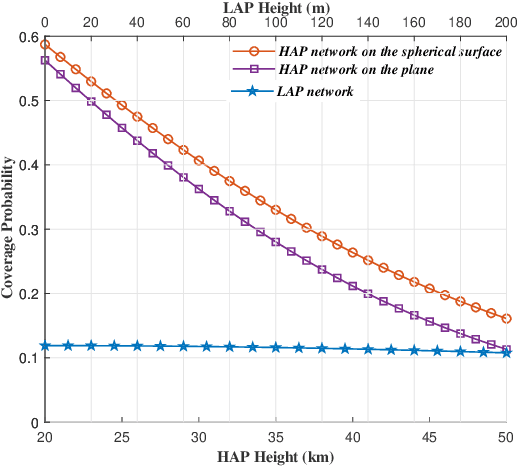
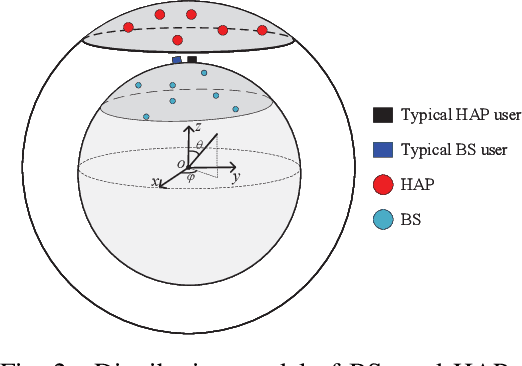
Abstract:Achieving seamless global coverage is one of the ultimate goals of space-air-ground integrated network, as a part of which High Altitude Platform (HAP) network can provide wide-area coverage. However, deploying a large number of HAPs will lead to severe congestion of existing frequency bands. Spectrum sharing improves spectrum utilization. The coverage performance improvement and interference caused by spectrum sharing need to be investigated. To this end, this paper analyzes the performance of spectrum sharing between HAP network and terrestrial network. We firstly generalize the Poisson Point Process (PPP) to curves, surfaces and manifolds to model the distribution of terrestrial Base Stations (BSs) and HAPs. Then, the closed-form expressions for coverage probability of HAP network and terrestrial network are derived based on differential geometry and stochastic geometry. We verify the accuracy of closed-form expressions by Monte Carlo simulation. The results show that HAP network has less interference to terrestrial network. Low height and suitable deployment density can improve the coverage probability and transmission capacity of HAP network.
Integrated Sensing and Communication Signals Towards 5G-A and 6G: A Survey
Jan 10, 2023



Abstract:Integrated sensing and communication (ISAC) has the advantages of efficient spectrum utilization and low hardware cost. It is promising to be implemented in the fifth-generation-advanced (5G-A) and sixth-generation (6G) mobile communication systems, having the potential to be applied in intelligent applications requiring both communication and high-accurate sensing capabilities. As the fundamental technology of ISAC, ISAC signal directly impacts the performance of sensing and communication. This article systematically reviews the literature on ISAC signals from the perspective of mobile communication systems, including ISAC signal design, ISAC signal processing algorithms and ISAC signal optimization. We first review the ISAC signal design based on 5G, 5G-A and 6G mobile communication systems. Then, radar signal processing methods are reviewed for ISAC signals, mainly including the channel information matrix method, spectrum lines estimator method and super resolution method. In terms of signal optimization, we summarize peak-to-average power ratio (PAPR) optimization, interference management, and adaptive signal optimization for ISAC signals. This article may provide the guidelines for the research of ISAC signals in 5G-A and 6G mobile communication systems.
Intelligent Reflecting Surface assisted Integrated Sensing and Communication System
Nov 11, 2022Abstract:High-speed communication and accurate sensing are of vital importance for future transportation system. Integrated sensing and communication (ISAC) system has the advantages of high spectrum efficiency and low hardware cost, satisfying the requirements of sensing and communication. Therefore, ISAC is considered to be a promising technology in the future transportation system. However, due to the low transmit power of signal and the influence of harsh transmission environment on radar sensing, the signal to noise ratio (SNR) at the radar receiver is low, which affects the sensing performance. This paper introduces the intelligent reflecting surface (IRS) into ISAC system. With IRS composed of M sub-surfaces implemented on the surface of the target. The SNR at the radar receiver is 20lg(M) times larger than the scheme without IRS. Correspondingly, radar detection probability is significantly improved, and Cramer-Rao Lower Bound (CRLB) for ranging and velocity estimation is reduced. This paper proves the efficiency of IRS enabled ISAC system, which motivates the implementation of IRS to enhance the sensing capability in ISAC system.
Rethinking the Performance of ISAC System: From Efficiency and Utility Perspectives
Aug 18, 2022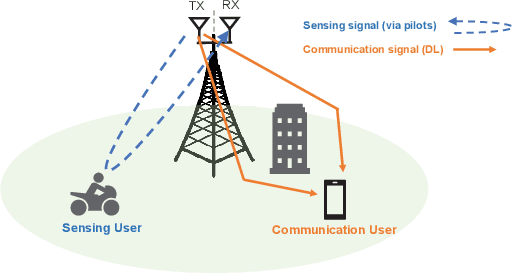

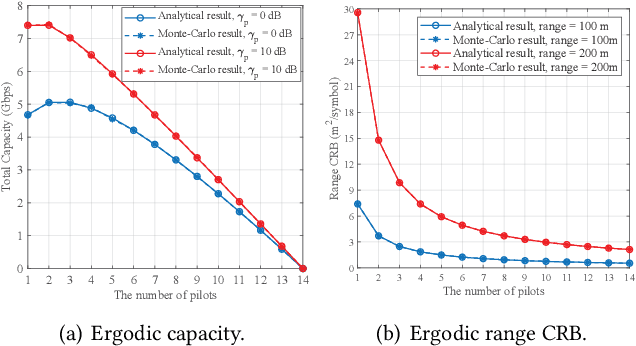
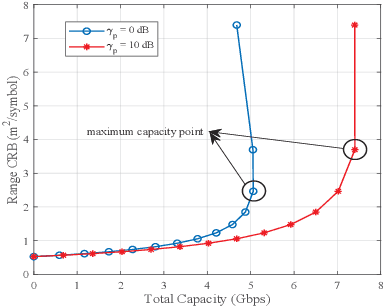
Abstract:Integrated sensing and communications (ISAC) is an essential technology for the 6G communication system, which enables the conventional wireless communication network capable of sensing targets around. The shared use of pilots is a promising strategy to achieve ISAC. It brings a trade-off between communication and sensing, which is still unclear under the imperfect channel estimation condition. To provide some insights, the trade-off between ergodic capacity with imperfect channel estimation and ergodic Cramer-Rao bound (CRB) of range sensing is investigated. Firstly, the closedform expressions of ergodic capacity and ergodic range CRB are derived, which are associated with the number of pilots. Secondly, two novel metrics named efficiency and utility are firstly proposed to evaluate the joint performance of capacity and range sensing error. Specifically, efficiency is used to evaluate the achievable capacity per unit of the sensing error, and utility is designed to evaluate the utilization degree of ISAC. Moreover, an algorithm of pilot length optimization is designed to achieve the best efficiency. Finally, simulation results are given to verify the accuracy of analytical results, and provide some insights on designing the slot structure.
Sensing as A Service in 6G Perceptive Networks: A Unified Framework for ISAC Resource Allocation
Feb 22, 2022


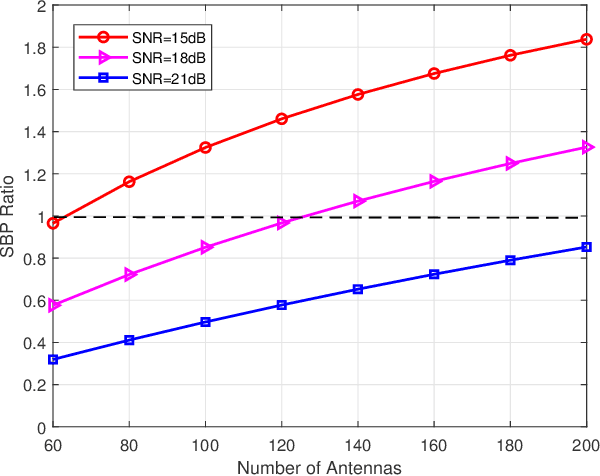
Abstract:In the upcoming next-generation (5G-Advanced and 6G) wireless networks, sensing as a service will play a more important role than ever before. Recently, the concept of perceptive network is proposed as a paradigm shift that provides sensing and communication (S&C) services simultaneously. This type of technology is typically referred to as Integrated Sensing and Communications (ISAC). In this paper, we propose the concept of sensing quality of service (QoS) in terms of diverse applications. Specifically, the probability of detection, the Cramer-Rao bound (CRB) for parameter estimation and the posterior CRB for moving target indication are employed to measure the sensing QoS for detection, localization, and tracking, respectively. Then, we establish a unified framework for ISAC resource allocation, where the fairness and the comprehensiveness optimization criteria are considered for the aforementioned sensing services. The proposed schemes can flexibly allocate the limited power and bandwidth resources according to both S&C QoSs. Finally, we study the performance trade-off between S&C services in different resource allocation schemes by numerical simulations.
 Add to Chrome
Add to Chrome Add to Firefox
Add to Firefox Add to Edge
Add to Edge